Host: Sylvia Rhor, Director, University Art Gallery.
Our week started off with a visit to the University Art Gallery, hosted by Gallery Director Sylvia Rhor. Rhor introduced us to selected works from the Gallery’s Gimbel collection, paintings commissioned in the 1940s by the Gimbels of department store fame. As Rhor explained, they encouraged artists to paint Pennsylvania “as they saw it.” Many focused on Pittsburgh as the state’s iconic city and steel capital of the world. We saw works by prominent social realist painters of the period, including William Gropper, Edward Millman, and Adolf Dehn and discussed their differing pictorial strategies for rendering the perils of coal mining, day-to-day life in the shadow of the mills, and labor in the “smoky city’s” steel industry. Several of the works provided a snapshot into working processes and technology that have changed dramatically over the decades due to automation, a theme of labor and its displacements that surfaced frequently in our discussions throughout the week.
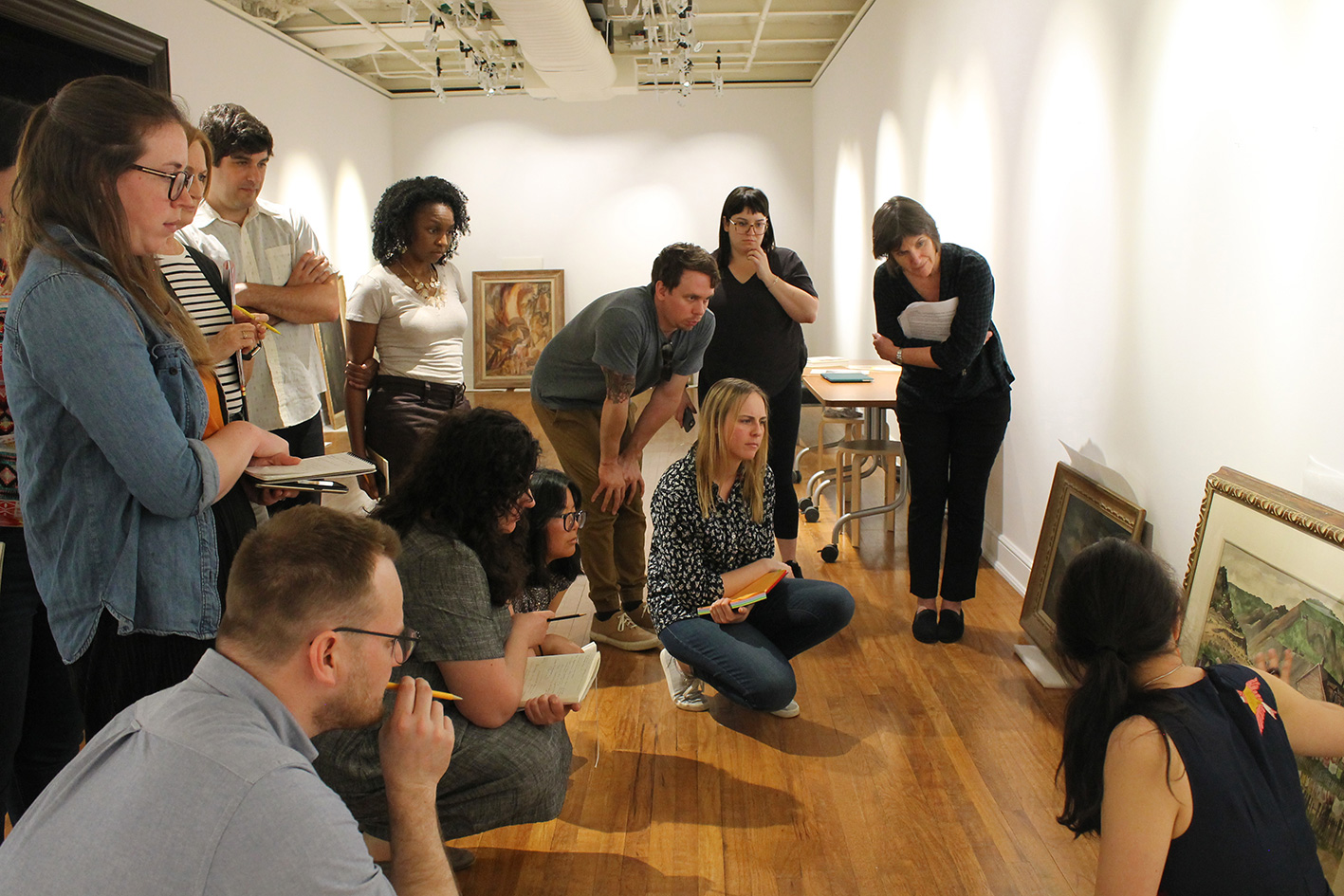
The University Art Gallery Director, Sylvia Rhor discussing Gallery’s Gimbel collection paintings with workshop participants
Hosts: Kiana Jones, Fine Arts Librarian; Kate Joranson, Head, Frick Fine Arts Library; Clare Withers, Curator, Elizabeth Nesbitt Collection.
Coordinated by Kiana Jones, this session brought together a rich selection of visual culture sources concerning the history of labor from across the collections of the University Library System. Recent library acquisitions of worker’s periodical The Lowell Offering from the 1840s provided a vivid picture of women’s labor in Massachusett’s textile mills at the outset of the American industrial revolution. From the American Left Ephemera Collection we inspected ephemera and artist illustrated periodicals from a range of communist and socialist causes from the 1890s until the 1960s. Alongside these radical publications, we inspected comic books and children’s books that grappled with the working class traditions and folklore, including William Gropper’s The Little Tailor and Lois Lenski’s Coal Camp Girl. From the Frick Fine Arts Library holdings, conceptual artist books by Don Celender, Martha Rosler, Fred Lonidier, Peter Lyssiotis and other allowed participants to explore both the correspondences and disparities between working class and artistic labor.
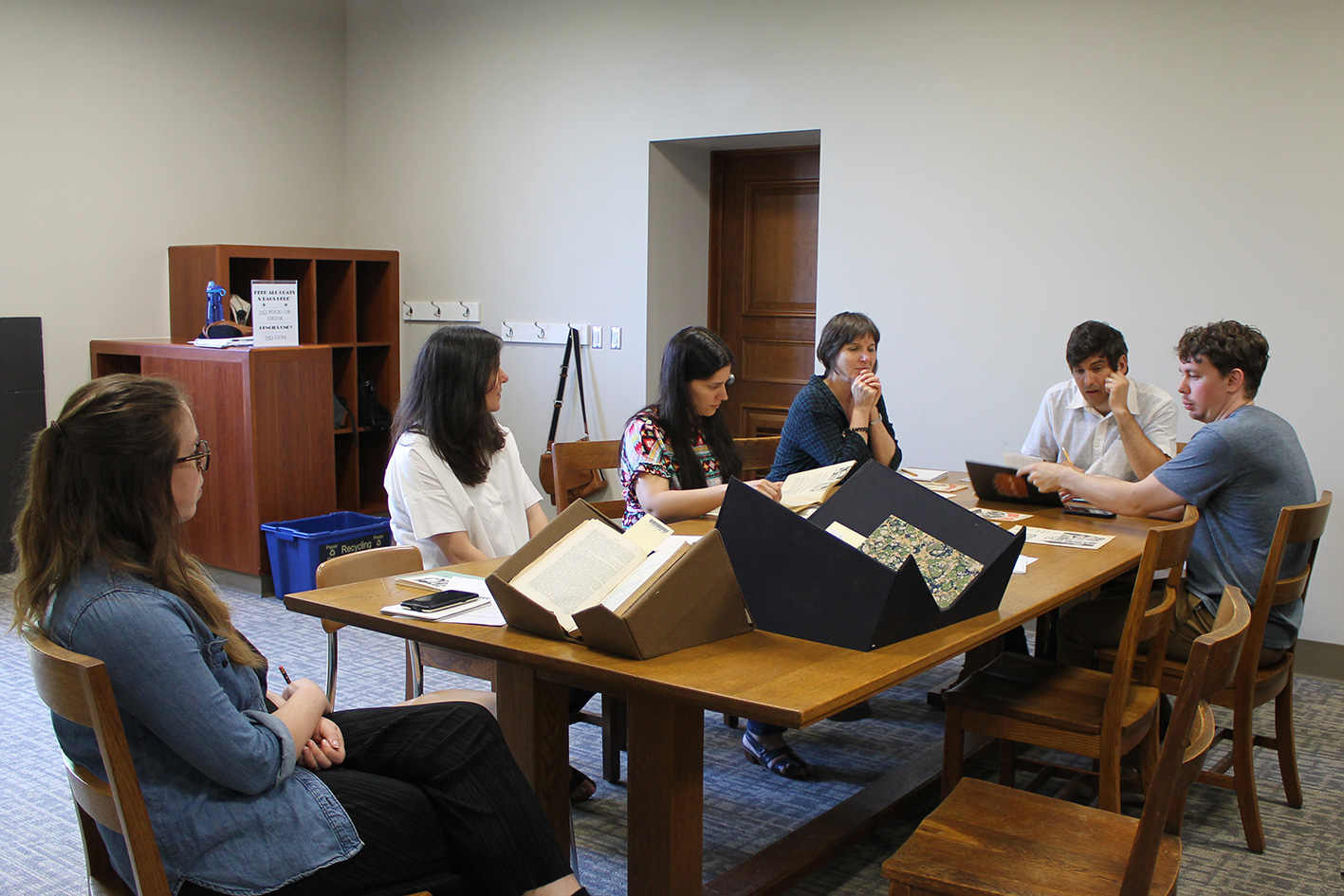
Workshop participants discussing the materials at the Frick Fine Arts Library
Hosts: John Paul Deley, Vice President and Director of Detre Library and Archives; Matthew Strauss, Chief Archivist; Sierra Green, Archivist; Carly Lough, Archivist; Bryan Brown, Project; Catelyn Coccuzzi, Project Archivist.
The extensive holdings of materials from Pittsburgh’s industrial giants in the collections of the Detre Library and Archives provided a major focus for our session at the Heinz History Center. John Paul Deley introduced a range of photographic and archival collections from Alcoa, U.S. Steel, H.J. Heinz Company, Westinghouse and Jones and Laughlin. From the latter collection, the group inspected original publicity photographs of steel production in which hand-painted retouching can be seen to elaborate the aesthetic drama of the factory environment. Participants explored the records of the Pittsburgh Typographical Union No. 7, the oldest continually existing labor union in the city, and historical issues from the United Steelworkers long-running journal Steel Labor. Another focus for the participants were the histories of automation and robotics especially evident through collections from the Westinghouse Company, material that was further enriched by seeing the company’s Elektro robot developed for the New York World’s Fair in 1939.

Workshop participants Mark Paterson and Michael MacKenzie exploring some of the materials at the Detre Library
Host: Sylvia Rhor, Director, University Art Gallery
On Wednesday, University Art Gallery Director Sylvia Rhor met us at the U.S Post Office and Courthouse in downtown Pittsburgh for a tour of two spectacular, large-scale murals produced for its courtrooms in the mid-1930s. Rhor, a specialist in public murals of the WPA era, provided us with historical and artistic context for Howard Norton Cook’s Steel Industry (1936) and Stuyvesant Van Veen’s Pittsburgh Panorama (1937). We considered how both artists took sides in labor disputes of the era by encoding their murals with themes of labor solidarity and egalitarianism. In the case of Van Veen’s mural, this also included his commitment to the revolutionary worker’s movement, which he signaled with the subtle inclusion of the hammer and sickle motif in his gritty panorama of the city. These murals foregrounded what made Pittsburgh the epicenter not only of industrial modernization, but also of art on the left that pressed for justice—in federal courtrooms no less—in the face of labor exploitation of the period.
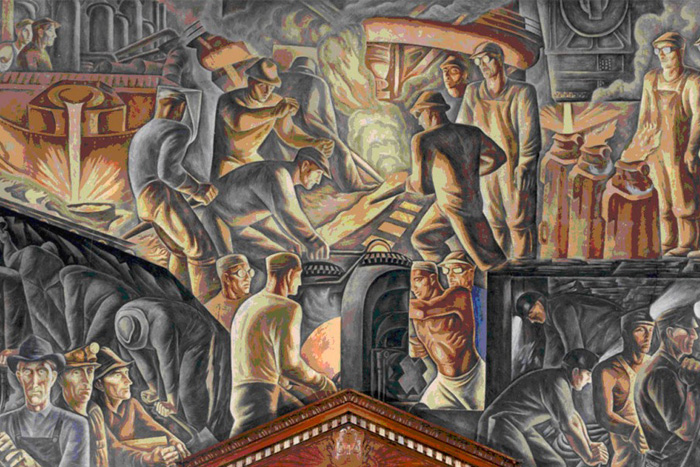
Detail of Howard Norton Cook’s Steel Industry mural
Hosts: Eric Crosby, Acting-Co Director and Richard Armstrong Senior Curator of Modern and Contemporary; Dan Leers, Curator of Photography; Dan Peterman, visiting artist; Hannah Turpin, Assistant Curator for Contemporary Art and Photography; Dominique Luster, Teenie Harris Archivist; Costas Karakatsanis, Fine Arts Curatorial Researcher; Ellen Baxter, Chief Conservator; Rachel Delphia, Curator of Decorative Arts.
As the key partner for the Work Forces workshop, participants spent a full day engaging with programs, collections and staff at the Carnegie Museum of Art. In the morning, Eric Crosby presented an overview of the museum’s forthcoming Working Thought exhibition and introduced the museum’s new acquisition of Fred Lonidier’s I Like Everything Nothing But Union (1983), a series of documentary photo panels originally commissioned for the offices of the San Diego-Imperial Counties Labor Council. Dominique Luster presented images of work and black-owned businesses from the museum’s collection of Teenie Harris photographs, and Dan Leers introduced the group to the pioneering industrial documentary Valley Town (1940), filmed in Pittsburgh and New Castle, Pennsylvania, to contextualize the melancholic film stills produced by cinematographer Robert E. Churchill now held in the museum’s collection.
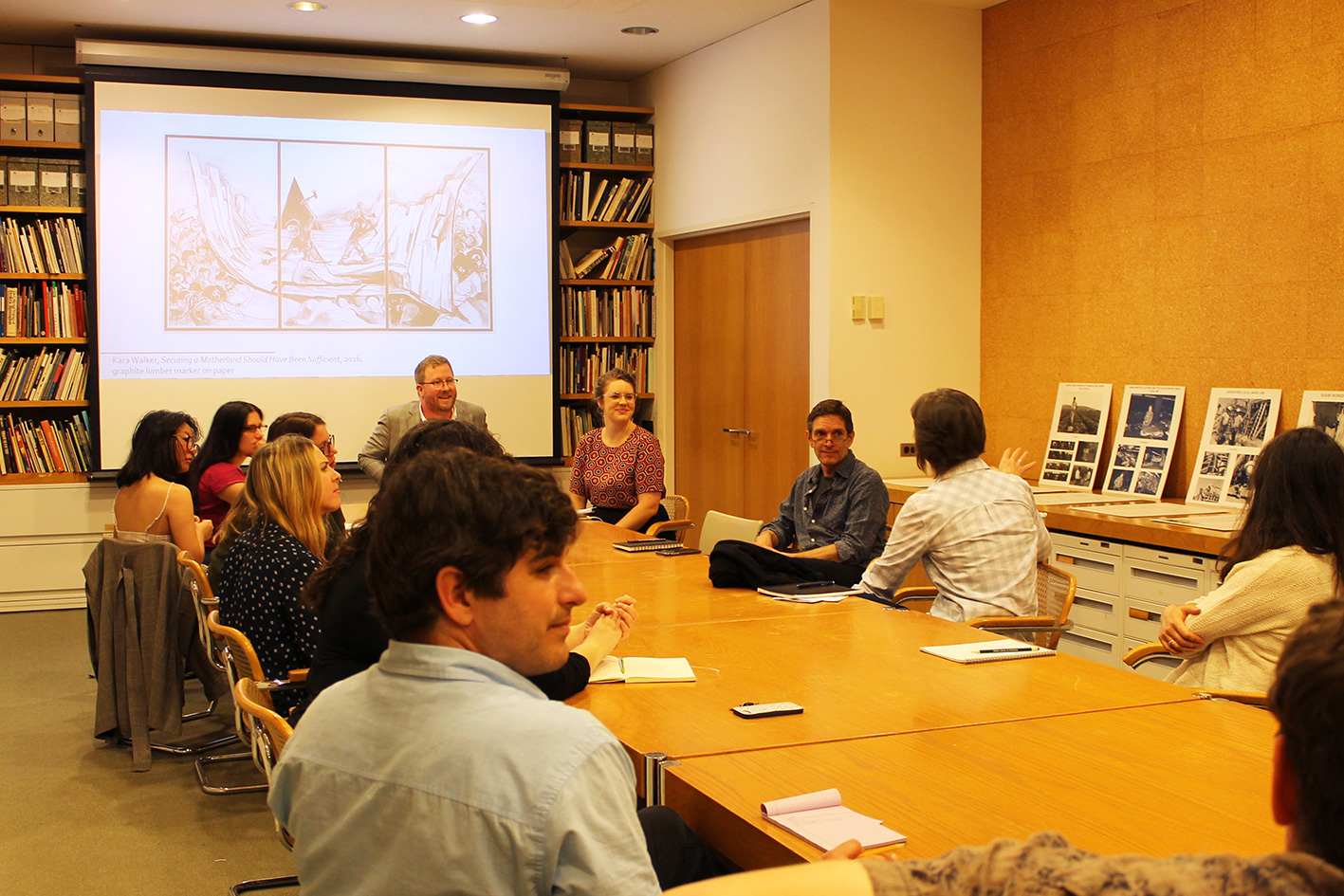
Eric Crosby, Hannah Turpin and visiting artist Dan Peterman in conversation with workshop participants
In the afternoon, Chicago-based artist and participant in the Working Thought exhibition Dan Peterman presented a survey of his engagement with labor and industrial materials, including his installation at documenta 14 that participated in the global circulation of steel and copper ingots. Costas Karakatsanis showed the group paintings by Saul Steinberg, Hedda Sterne, Antonio Frasconi and Walter Tandy Murch commissioned by the Joy Manufacturing Company to promote their Continuous Mining Machine, a major innovation in the automation of the coal industry. The museum’s Chief Conservator Ellen Baxter toured the group through John White Alexander’s The Crowning of Labor, whose allegorical handling of the productive glories of Pittsburgh smoke itself required careful treatment to clean the impacts of industrial pollution. Finally, Rachel Delphia hosted a behind-the-scenes preview of a new decorative arts display for the museum’s Ailsa Mellon Bruce galleries that represent a new focus on materials and the processes of making.
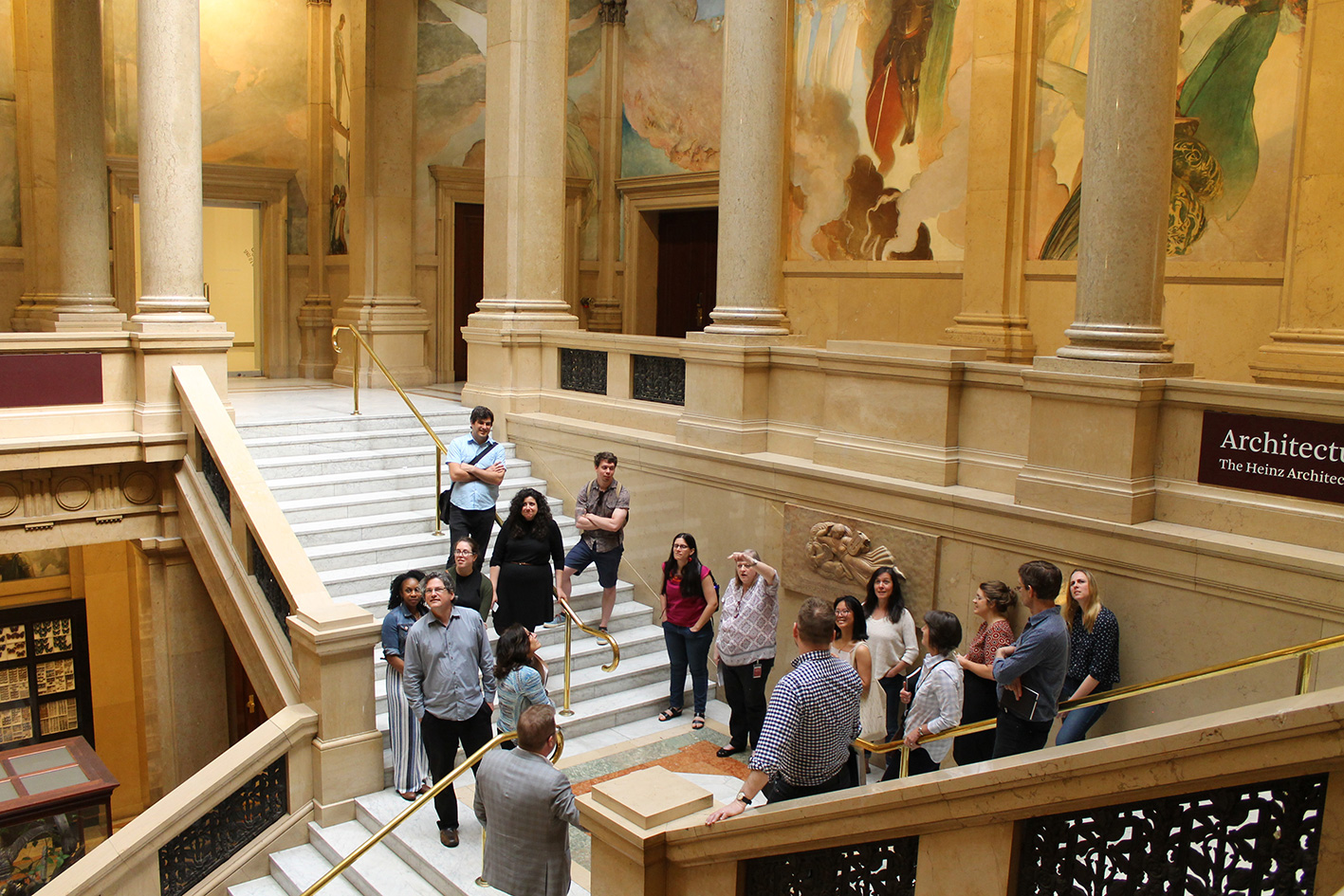
Workshop participants at the Grand Staircase contemplating John White Alexander’s The Crowning of Labor murals
Host: Ron Baraff, Director of Historic Resources and Facilities; Ryan Henderson, Interpretative Specialist; Melanie Root, Archivist.
On Thursday morning, the group drove out to Carrie Furnaces, built in 1907 to produce iron for the Homestead Steel works across the river. The Furnaces are the center of attraction for the Rivers of Steel National Heritage Area. We were met by Ron Baraff, who introduced us to the history of the site and its ongoing work of preserving important traces of Pittsburgh’s labor history. We toured the inner workings of the blast furnaces and saw where molten iron was produced and poured into brick-lined tank cars for shuttling across a hot metal bridge to steel fabrication at the Homestead works. We then visited the Bost Building in Homestead, which served as the headquarters of the Amalgamated Association of Iron and Steel Workers during the Homestead Strike of 1892. Interpretive Specialist Ryan Henderson and Archivist Melanie Root introduced us to the resources of this site and its extensive archival holdings. Through photographic records, memorabilia, and written documentation, the Bost holdings provided us with extraordinary insight into the day-to-day operations of Pittsburgh’s historic steel industry.
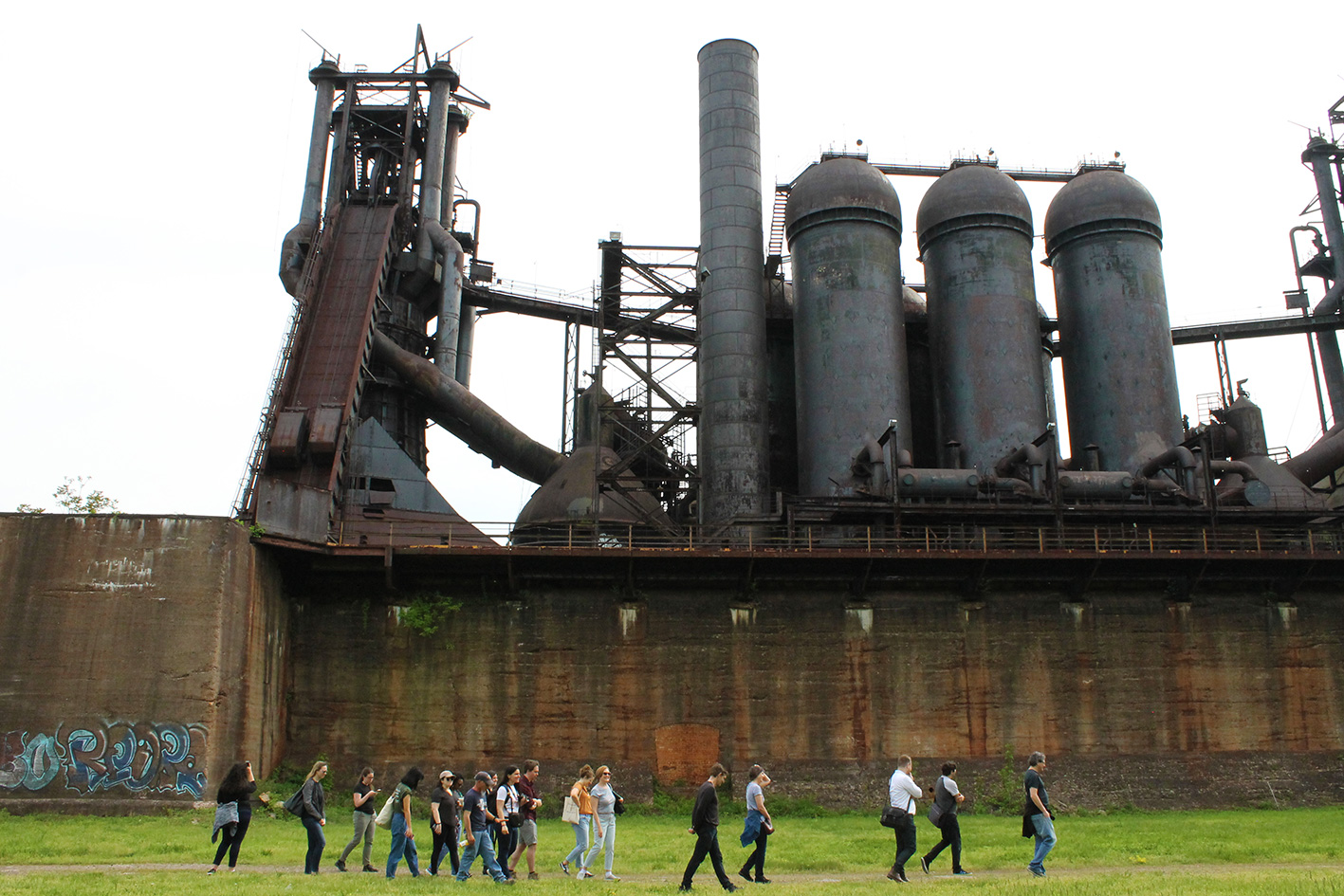
Workshop participants at the Carrie Furnace
Hosts: Bob Black, President; Larry Kurtik, General Manager.
On Thursday afternoon, the group ventured beyond the Collecting Knowledge Pittsburgh partners to visit the Old Avenue Mine in Tarentum, now known as the Tour-Ed Mine and Museum. Workshop participants took a coal car half a mile underground to survey mining technologies and techniques from late nineteenth century mining by a hand pick through to the introduction of labor-saving machinery in the first half of the twentieth century, and concluding with the introduction of Joy Manufacturing’s monstrous Continuous Mining Machine in the late 1940s. Hosts Bob Black and Larry Kurtik provided participants with insights into working conditions for mine workers, from the challenges of scrip and the company store to the health and safety challenges of gas and dust.
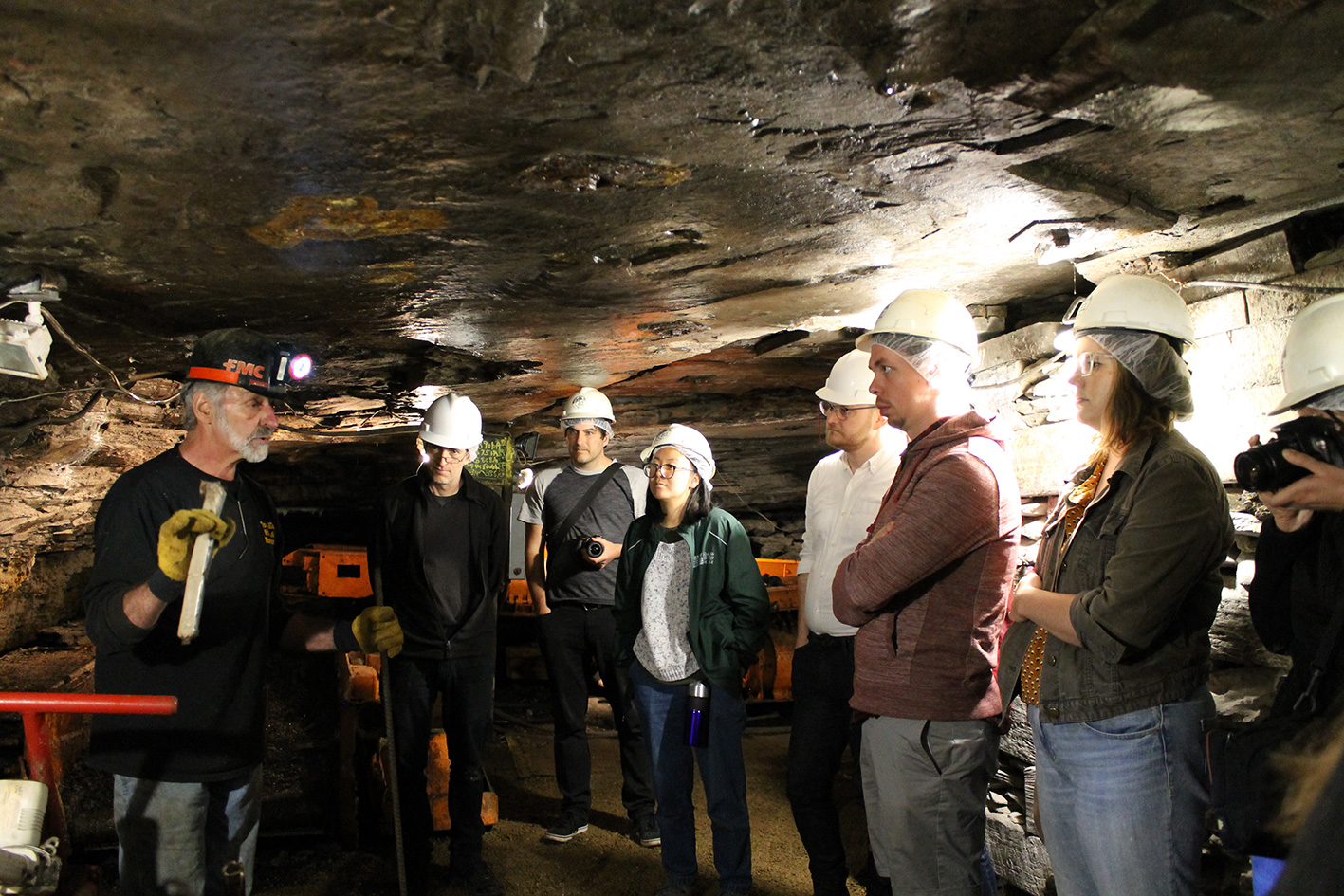
Workshop participants underground at the old Avenue Mine
Host: David Grinnell, Coordinator of Archives and Manuscripts; Miriam Meislik, Media Curator; Zachary Brodt, Archivist; Bill Daw, Curator Curtis Theatre Collection; Megan Massanelli, Kuntu Repertory Theatre Project Archivist.
Coordinated by David Grinnell, with contributions by Zach Brodt, Miriam Meislik, Megan Massanelli and Bill Daw, the final collection-based session of the workshop explored holdings of the University Library System at Thomas Boulevard. In several instances, the records of government agencies provided vivid sources regarding the challenges of working life in late nineteenth and early twentieth century Pittsburgh, including the Allegheny County Coroner’s Reports from the 1915 Union Box Company Fire. More contemporary materials included newsletters and posters from the 1970s faculty unionization campaign at the University of Pittsburgh, and a selection of cartoons by labor cartoonist and activist Fred Wright engaged with issues of automation and workplace gender relations. From the records of U. S. Steel’s National-Duquesne Works we inspected historical worker’s compensation files and surveillance photographs of striking workers, while the records the Pittsburgh branch of the NAACP revealed first-hand accounts of the hiring experiences of African-American women seeking employment in Downtown stores.
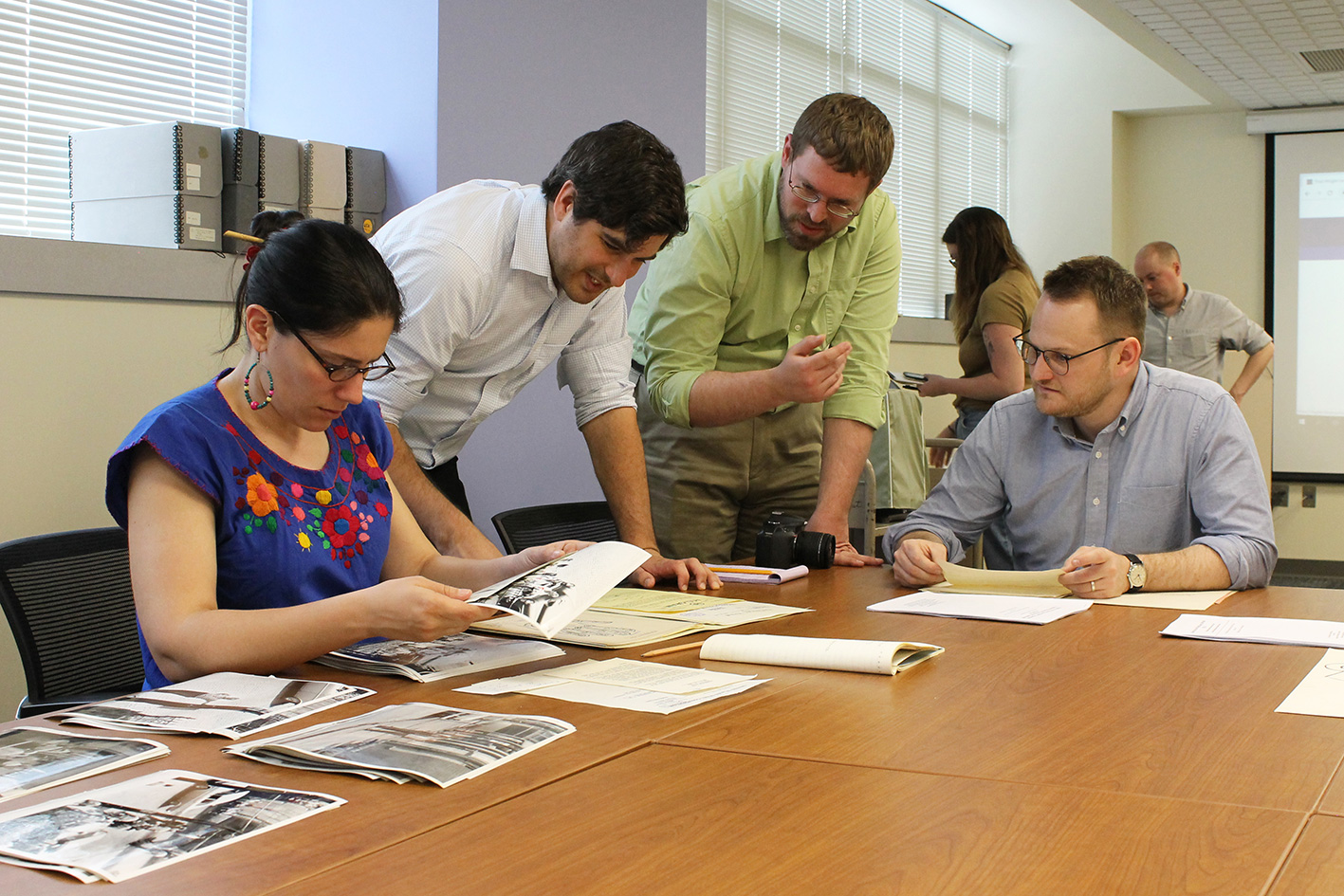
Workshop participants exploring surveillance photographs of striking workers at the Archives Service Center, University Library System
